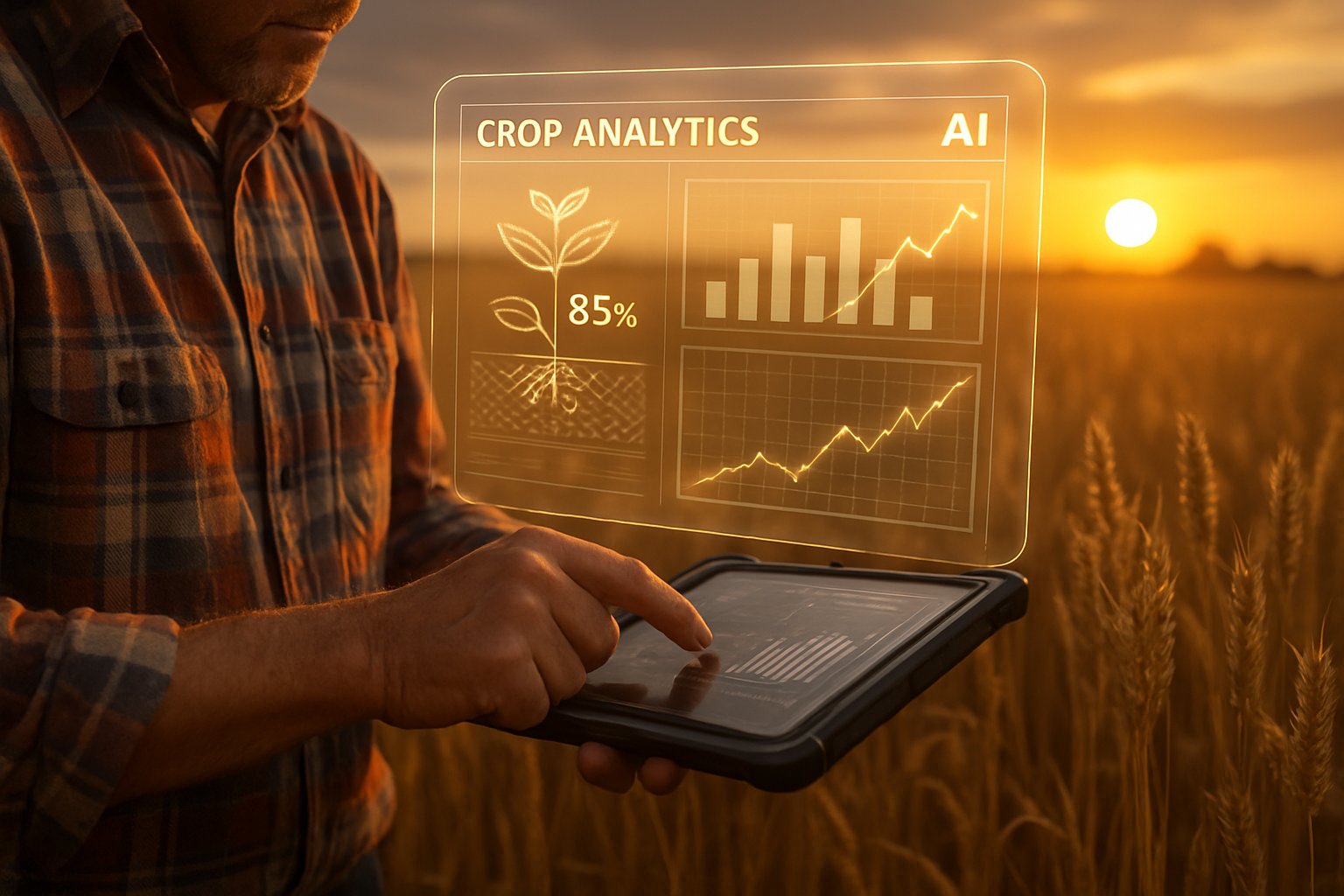
AI CERTS
3 hours ago
Agricultural AI Drives Double-Digit Yield Growth
Market Momentum Builds Up
Global spending on AI crop monitoring reached about $3.4 billion in 2025. Moreover, Stratistics MRC projects growth to $12.7 billion by 2032, implying a 20 percent CAGR. John Deere scaled its See & Spray system across five million acres, reporting herbicide cuts near 50 percent and modest soybean yield bumps. Meanwhile, agribusiness giants expand cloud-based platforms that blend remote sensing, sensors, and analytics.

These figures highlight soaring investor confidence. Nevertheless, independent economists urge caution. They note market forecasts often rely on optimistic adoption curves. Consequently, verifying actual on-farm impact remains critical.
Accelerating commercial deployment underscores urgent skills gaps. Professionals can validate expertise through the AI Data Robotics™ certification.
Momentum signals opportunity for vendors and growers alike. However, understanding evidence quality is essential before scaling further.
Evidence Behind Yield Claims
Headline figures vary widely. A 2025 meta-analysis covering digital information tools found average yield gains near six percent. Additionally, a causal inference study on cotton sowing showed 12-17 percent improvements when farmers followed algorithmic advice. In contrast, vendor case studies sometimes report 10-30 percent jumps, yet often lack randomised controls.
Consider the following snapshot of reported impacts:
- Meta-analysis average: +6 percent (95 percent CI: +2 to +9).
- Cotton advisory trial: +12-17 percent.
- See & Spray soybean bump: +2 bushels per acre.
- Select pilots: up to 28 percent under favourable conditions.
These numbers reveal substantial heterogeneity. Therefore, journalists should always request methodologies, baselines, and control descriptions. Transparent data sharing strengthens credibility and accelerates sector learning.
Evidence shows consistent though moderate benefits overall. Consequently, networks should match technology choices to crop, climate, and management style before expecting double-digit returns.
Core Technologies Explained Clearly
Multiple tools power modern Agricultural AI. Satellite and drone imagery feed vegetation indices such as NDVI and NDRE. Furthermore, in-field sensors track moisture, nutrients, and canopy temperature. Machine-learning models fuse these inputs, flagging stress before visible symptoms emerge.
Prescription maps then drive variable-rate applications. Consequently, growers target inputs precisely, lowering waste while safeguarding yields. Edge computing allows real-time analytics in connectivity-poor regions. Meanwhile, cloud platforms enable heavier models and larger datasets.
Key solution types fall into three categories:
- Remote sensing analytics.
- Sensor-driven decision support.
- Autonomous or assisted machinery.
Each category contributes differently to Precision Farming and Food Security goals. Nevertheless, integration across categories delivers the highest value.
Understanding these layers clarifies why some pilots soar while others stall. Subsequently, we examine remaining hurdles.
Adoption Barriers Persist Globally
Despite promise, uptake remains uneven. Many smallholders lack affordable connectivity, capital, or digital literacy. Moreover, doubts linger about data ownership and liability if algorithms misfire. Surveys reveal larger enterprises adopt faster, widening productivity gaps.
Additional challenges include:
- High hardware costs for drones and sensors.
- Fragmented data standards limiting interoperability.
- Need for agronomists who can interpret AI outputs.
- Regulatory uncertainty surrounding farm data privacy.
Consequently, average gains hover near six percent rather than headline 28 percent. Nevertheless, tailored extension services and local trials can bridge the divide.
These hurdles dampen scaling speed. However, innovative financing models and new standards may unlock broader benefits soon.
Strategic Value For Networks
Farm networks integrate Agricultural AI to stabilise supply chains and enhance Food Security. Furthermore, processors like PepsiCo link sensor data to contract terms, improving quality assurance and harvest timing. Improved traceability also satisfies consumer demand for sustainable sourcing.
From a financial view, return on investment extends beyond yield. Variable-rate spraying reduces herbicide costs by up to 60 percent. Additionally, carbon programmes reward emission reductions generated through precise input usage.
For cooperatives, shared analytics lower individual subscription fees. Consequently, even modest yield lifts translate into strong collective revenue growth. Meanwhile, public agencies see Precision Farming as a lever for climate adaptation grants.
Strategic benefits diversify income and mitigate risk. Therefore, stakeholders cannot ignore the competitive edge delivered by reliable data pipelines.
Outlook And Next Steps
Analysts expect continued double-digit market growth. Nevertheless, rigorous field trials must keep pace with scaling deployments. Researchers plan broader randomised studies that isolate algorithmic impacts across diverse geographies.
Policy makers can accelerate impact by investing in rural broadband and open data standards. Moreover, ethical frameworks around farm data will build much-needed trust. Professionals should pursue continuous education, for example via the AI Data Robotics™ program, ensuring they can evaluate evolving toolsets critically.
Future success hinges on transparent evidence sharing and collaborative innovation. Consequently, balanced reporting remains essential as bold claims proliferate.
Robust verification and inclusive design will decide whether Agricultural AI fulfils its promise for farmers and consumers alike.
Therefore, the next wave of solutions must couple technical excellence with accessible support services.
Conclusion
Agricultural AI now permeates global farm networks, delivering verified though variable yield gains. Furthermore, evidence suggests average improvements near six percent, with standout pilots approaching 28 percent. Adoption hurdles persist, yet evolving financing, standards, and certifications empower wider uptake. Consequently, stakeholders should demand transparent data, invest in skills, and pilot context-specific solutions. Explore certification pathways today and lead the transformation toward resilient, data-driven agriculture.



